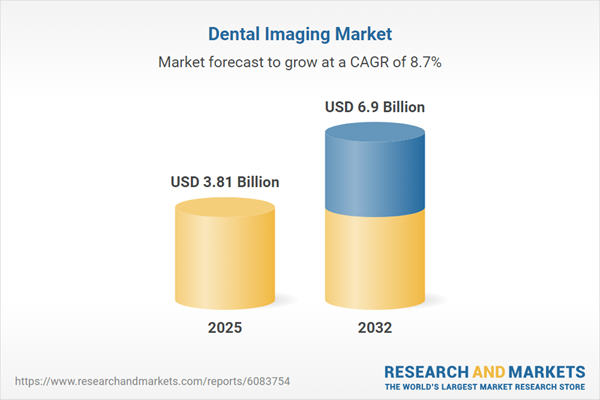Speak directly to the analyst to clarify any post sales queries you may have.
The dental imaging market is undergoing rapid transformation, fueled by advances in digital technologies and shifting regulatory environments. Senior decision-makers face increasing pressure to adopt solutions that balance diagnostic excellence, operational efficiency, and compliance with global standards.
Market Snapshot: Dental Imaging Market Growth and Trends
The Dental Imaging Market grew from USD 3.52 billion in 2024 to USD 3.81 billion in 2025. It is expected to continue growing at a CAGR of 8.74%, reaching USD 6.90 billion by 2032. Growth is attributed to the shift from traditional X-rays to digital diagnostics, the rise of three-dimensional imaging, and technology convergence with patient management platforms. Strategic adaptation to persistent market evolution, complex supply chains, and new regulations remains vital for business continuity and leadership.
Scope & Segmentation
This report presents actionable intelligence for stakeholders across multiple dental imaging segments and global regions, offering a clear view of evolving demands and solution adoption.
- Offering: Instruments & Kits; Software
- Product Type: Extraoral (Cephalometric, Cone Beam Computed Tomography, Panoramic); Intraoral (Bitewing, Periapical)
- Technology: Three-Dimensional Imaging; Two-Dimensional Imaging
- Application: Diagnosis; Patient Education & Communication; Post-Treatment Monitoring; Surgical Guidance; Treatment Planning
- Treatment: Endodontics; General Dentistry; Implantology; Oral Surgery; Orthodontics
- End User: Academic & Research Institutes; Dental Clinics; Diagnostic Imaging Centers; Hospitals
- Region: Americas (North America: United States, Canada, Mexico; Latin America: Brazil, Argentina, Chile, Colombia, Peru); Europe, Middle East & Africa (Europe: United Kingdom, Germany, France, Russia, Italy, Spain, Netherlands, Sweden, Poland, Switzerland; Middle East: United Arab Emirates, Saudi Arabia, Qatar, Turkey, Israel; Africa: South Africa, Nigeria, Egypt, Kenya); Asia-Pacific (China, India, Japan, Australia, South Korea, Indonesia, Thailand, Malaysia, Singapore, Taiwan)
- Leading Companies: 3Shape A/S, ACTEON SA, Align Technology Inc., Carestream Health Inc., Carl Zeiss AG, Dental Imaging Technologies Corporation, DENTSPLY SIRONA Inc., Detection Technology Plc, DÜRR DENTAL India Private Limited, e-con Systems, Eastman Kodak Company, Envista Holdings Corporation, Excelitas Technologies Corp., GE HealthCare, HAMAMATSU Group, Henry Schein Inc., Imaging Technologies Ltd, J. MORITA CORP., KaVo Dental GmbH, Leica Microsystems by Danaher Corporation, Midmark Corporation, Owandy Radiology, Planmeca Oy, Refine Medical, Seiler Instrument Inc., Vatech Co. Ltd., Xline S.r.l.
Key Takeaways
- Directional trends show a decisive migration towards digital and volumetric imaging modalities, with software-driven analytics gaining influence within clinical workflows.
- Integration of artificial intelligence and cloud platforms advances diagnostic accuracy, supports teledentistry, and enables multidisciplinary collaboration across care teams.
- Regional variations remain pronounced; established markets invest in advanced modalities while emerging regions focus on accessibility, portable units, and cost-effective upgrades.
- Leading manufacturers invest in modular system design, creating upgrade pathways and extending equipment lifecycles for greater cost efficiency and compliance.
- Strategic partnerships—including collaborations with technology developers and academic institutions—bolster competitive positioning and speed the translation of R&D into clinical applications.
Tariff Impact
New tariffs implemented in 2025 have introduced cost challenges for imported dental imaging equipment and components. These measures have led dental practices and suppliers to pivot sourcing strategies, prioritize domestic manufacturing, and negotiate more favorable service and maintenance terms. The realignment of supplier relationships and investment in local assembly underline the resilience and strategic adaptation of market leaders.
Methodology & Data Sources
Research for this report combined in-depth secondary data analysis with primary interviews conducted across practitioners, manufacturers, distributors, and regulatory experts. Segmentation, regional, and company-level trends were validated through data triangulation, using both top-down and bottom-up analytical approaches to ensure robust, actionable insights for stakeholders.
Why This Report Matters
- Enables senior leaders to benchmark market positioning and adopt best-practice sourcing and partnership strategies amid volatile regulatory climates.
- Provides insights for capital allocation across technologies, applications, and regional markets by linking trends to business outcomes.
- Offers operational guidance on responding to tariff pressures, workflow integration, and emerging customer demands.
Conclusion
The dental imaging market is entering a new era of digital innovation and strategic complexity. Decision-makers who invest in connected, future-ready solutions and adaptive operating models will be best positioned to lead in dynamic, competitive environments.
Table of Contents
3. Executive Summary
4. Market Overview
7. Cumulative Impact of Artificial Intelligence 2025
Companies Mentioned
The companies profiled in this Dental Imaging market report include:- 3Shape A/S
- ACTEON SA
- Align Technology, Inc.
- Carestream Health, Inc.
- Carl Zeiss AG
- Dental Imaging Technologies Corporation
- DENTSPLY SIRONA Inc.
- Detection Technology Plc
- DÜRR DENTAL India Private Limited
- e-con Systems
- Eastman Kodak Company
- Envista Holdings Corporation
- Excelitas Technologies Corp.
- GE HealthCare
- HAMAMATSU Group
- Henry Schein, Inc.
- Imaging Technologies Ltd
- J. MORITA CORP.
- KaVo Dental GmbH
- Leica Microsystems by Danaher Corporation
- Midmark Corporation
- Owandy Radiology
- Planmeca Oy
- Refine Medical
- Seiler Instrument Inc.
- Vatech Co., Ltd.
- Xline S.r.l.
Table Information
| Report Attribute | Details |
|---|---|
| No. of Pages | 184 |
| Published | November 2025 |
| Forecast Period | 2025 - 2032 |
| Estimated Market Value ( USD | $ 3.81 Billion |
| Forecasted Market Value ( USD | $ 6.9 Billion |
| Compound Annual Growth Rate | 8.7% |
| Regions Covered | Global |
| No. of Companies Mentioned | 28 |









